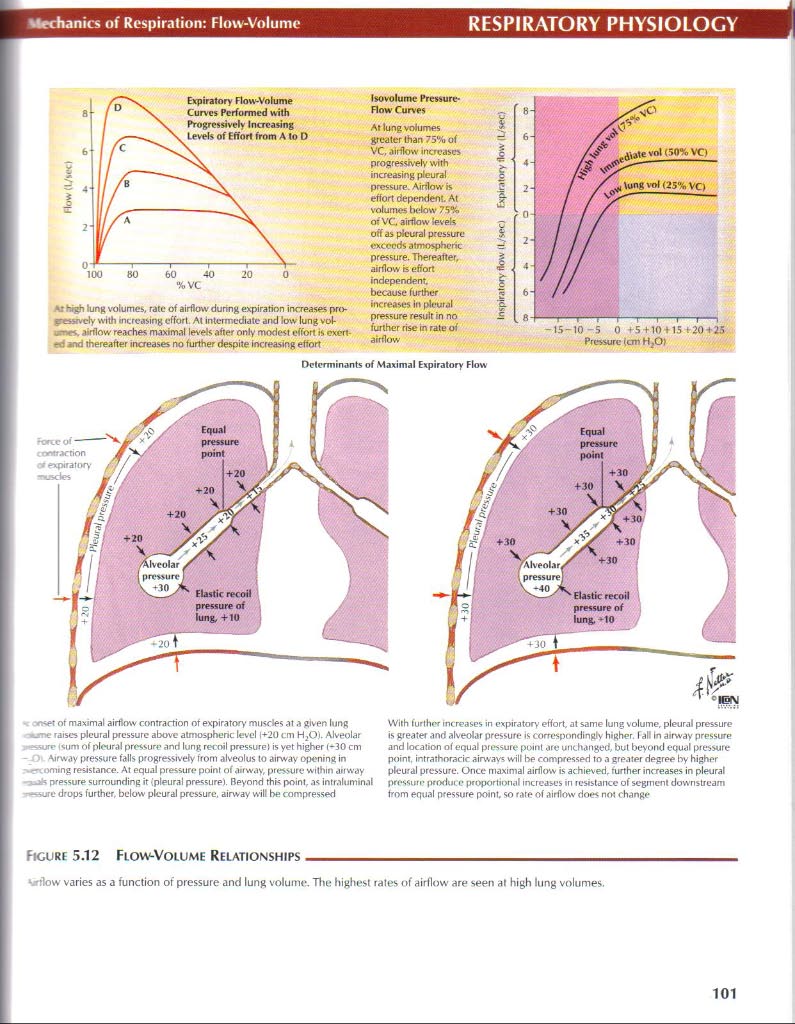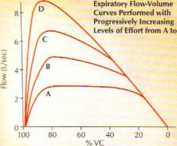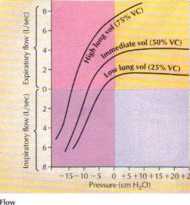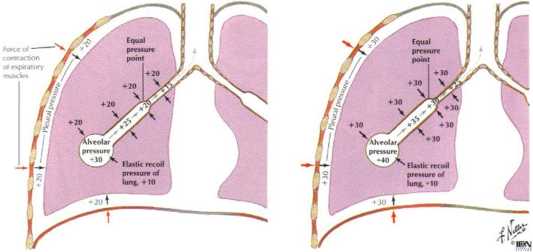netter86

.'et tianics of Rcspiration: Flow-Volume
RESPIRATORY PHYSIOLOGY

V high lung vołumes, ratę of airflow dunng expiration inereases pro-gressivcly with inucasing effort. At intcrmcdiate and Iow lung vol-airflow rearhes maximal levek after only modeli effort is cxort «f and thereafter inereases no further despile inereasiog effort
Dctcrminanl

At lung voiumes greater than 75% of VC, airflow inereases progressóely with inereasing pleural pressure. Airflow Is effort dependent. At volumes helów 75% of VC. airflow tevels otf as płcural pressurc excecds atmospherie pressure. Thereafter, airflow ts effort independent, because further inereases In pleural pressure result in no further rise in ratę of
; of Maximal Expiratory

jrwet of maximal airflow contraction of expiratory muscles at a given lung *-me raiscs pleural pressurc abovc atmosphenc level 1+20 cm H20). Alveolar -"•urr Kum of pleural pressurc and lung recoil pressure) is yet higher 1—30 cm Airway pressure falls progressiveły from alveolus to airway oponing in en ommg resistance. At equal pressure point of airway, pressure within an way pressure surrounding it (pleural pressure). Beyond rhk point, as intr.ilumin.il —-surę drops further, bclow pleural pressure. airway will be compressed
With further inereases in expiratory effort, at same lung volume, pleural pressure is greater and alveolar pressure is correspondingK higher. Tali In airway pressure and location of equal pressure point are unchanged, but beyond equal pressure point, intrathoracic airways will be compressed to a greater degree by higher pleural pressure. Once maximal airflow is achieved, further inereases in pleural pressure prpducc proportional inereases in resistance of segment downstream from equal pressure point, so ratę of airflow doe< not change
Figurę 5.12 FlowVoi.ume Relationships_
*wrlow varies as a function of pressure and lung volume. Tlie highesl rales of airflow are seen at high lung yolumes.
101
Wyszukiwarka
Podobne podstrony:
23704 netter100 JłKtructiye Lung DiseaseRESPIRATORY PHYSIOLOGY Masimum Expiratorv Flow-Volume Curves
netter120 ienal Produclion of New HCO,RENAL PHYSIOLOGY NH4A - acid Net Acid txcretion(NAE)«(UuxV) -
12434 netter57 Eleclrital Activity of the HeartCARDIOYASCULAR PHYSIOLOCY Aclion Potential of SA Node
77961 netter56 Conduction System of the HeartCARDIOYASCULAR PHYSIOLOGY Superior vena A. Right Side M
netter72 imrTr— Reguiation of Blood PrcssureCARDIOVASCULAR PHYSIOLOCY Response to Increased Blood Yo
netter76 Airway Struclure: Trachea and Major BronchiRESPIRATORY PHYSIOLOGY Thyroid cartilage -Cricot
File0035 Crossing cultures I Mn understand et profile of a finmons film dirutor. 1 Look at the
1696 CHAUVEAU et al BLOOD. 1 SEPTEMBER 20C6 • VOLUME 106. NU MB ER 5Flow cytometry Rat !)Cs were sta
5 r. truł. ircłs Contn /Vtttoss/ono! Stfindćłrc/s Co/ PSC con/pr/ses: et Member of t/io tnst/tute .
więcej podobnych podstron